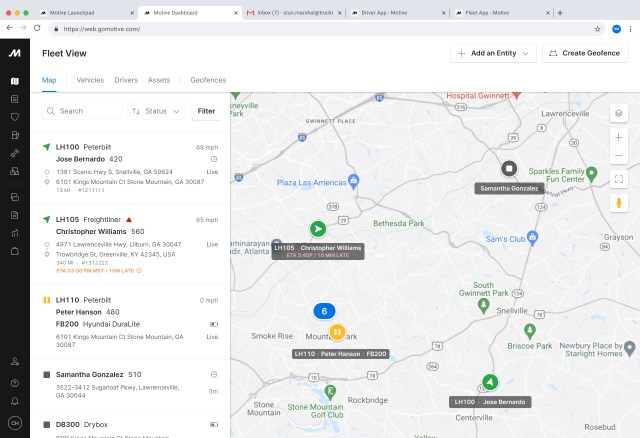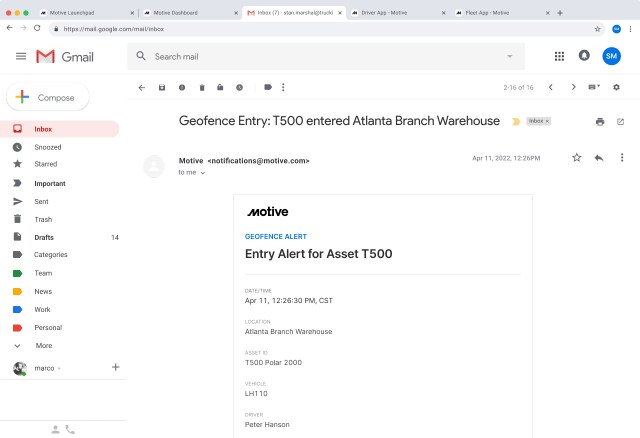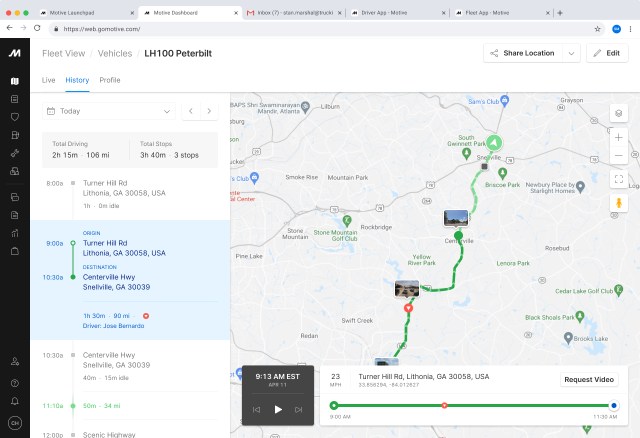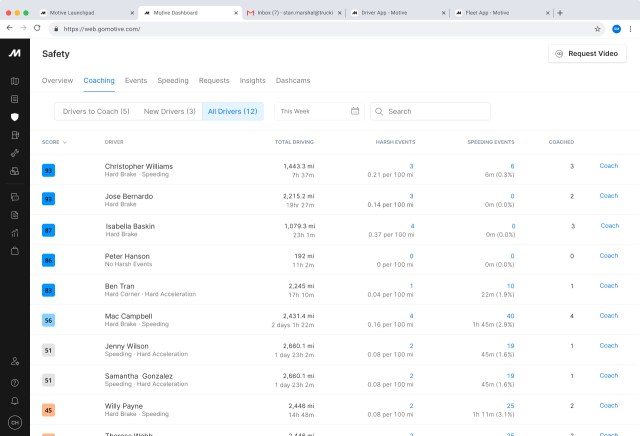Changes in consumer expectations (e.g. “the Amazon effect”) have caused rapid changes throughout all parts of the supply chain. Being able to track and communicate where trucks are and when they’ll reach their destination has become essential.
For this reason, truck-based businesses, from long haul to local delivery, are increasingly adopting GPS truck tracking software.
In this article, we’ll explain the ins and outs of truck tracking software for your fleet, including:
- How does truck tracking software work?
- Who uses truck tracking software and why?
- What benefits should truck tracking software provide?
- Key truck tracking software features
- How to use truck tracking in your business
- Tips to choose the right truck tracking solution
- Truck tracking FAQs
How does truck tracking software work?
A small telematics device that connects to a truck’s on-board diagnostic port is the central piece of truck tracking software. This telematics device is also commonly known as an Electronic Logging Device or GPS tracker, depending on the industry. While there are many ways to install the device, leading solutions are “plug-and-play” and do not require a mechanic or downtime.
The telematics device collects truck data such as GPS location, distance traveled, speed, fault codes, fuel usage, idling, harsh braking, and bearing.
Typically, the telematics device will then send the truck data to an online dashboard through a cellular or WiFi connection. The data is then reformatted and organized into intuitive tools, reports, and alerts that can be used to better manage your business.
Additionally, some truck tracking software providers have a driver-facing mobile app. Mobile apps are often used for compliance, driver communication, and a wide array of efficiency /coaching tools. This mobile app receives data from the telematics device through Bluetooth, USB, or cellular connection.
Who uses truck tracking software and why?
A wide range of industries use truck tracking software as a key part of their operations.
Trucking companies have an extremely high adoption rate of truck tracking software. One reason is the FMCSA’s ELD mandate, which necessitates similar technology for most interstate trucks to maintain Hours of Service compliance.
The other reason is the “Amazon effect.” The rise of fast shipping expectations and on-demand manufacturing models have made connectivity and ETA accuracy critical to operations. Many shippers and receivers will only work with trucking companies who can provide real-time visibility into the location and ETA of their freight.
Local delivery companies were some of the earliest adopters of truck tracking software. They started adding truck tracking software to keep customers informed of ETA’s without time-consuming phone calls and to plan more efficient delivery routes to stay cost-competitive.
Construction companies are also frequent users of truck tracking software, but with a twist. They frequently use the technology to track equipment and assets, along with trucks. This has allowed them to greatly reduce the time spent hunting for equipment across job sites and streamline the billing process.
Other industries that commonly use truck tracking software include oil and gas, mining, towing, field services, governments, among many others.
Truck tracking software is used by businesses of all sizes. Small businesses with a few trucks and large businesses with thousands of trucks can use similar software to track and manage their trucks.
Why should my business adopt truck tracking software?
There are many proven benefits to truck tracking software, including:
Improving the customer experience
Retaining customers is key to profitability. In fact, a 5 percent increase in customer retention produces a 25 percent increase in profits. Additionally, customers are your best sales reps, as 86-95 percent of consumers read online reviews before choosing a vendor.
Many businesses find they can improve the customer experience with truck tracking software. Here are a few examples:
- Planning efficient driver routes and daily schedules to increase on-time percentages
- Automated ETA notifications for customers
- Faster response times for customer emergencies by being able to easily locate and redirect the closest driver
- Detailed reports of when a truck arrived and left a job in the case of customer disputes
Streamlining and automating manual processes
Every minute spent on manual tasks is one not invested in growth. Truck tracking software can automate many manual tasks and processes so you can operate with less back-office overhead and focus on value-added activities.
Here are a few examples of tasks that can be automated:
- Calling drivers to dispatch job/loads and requesting ETA/status updates
- Searching the yard or job sites for specific trucks, trailers, or equipment
- Collecting and centralizing paperwork such as proof of delivery, forms, and fuel receipts
- IFTA, vehicle inspection, and hours of service reporting
Controlling and reducing operating costs
Truck-based businesses often come with significant costs that can eat away a significant amount of your profit if not managed closely. Truck tracking software can help control costs by:
- Reducing fuel usage, vehicle wear, and unproductive miles with more efficient driver assignment and route planning
- Locating stolen trucks or other assets
- Avoiding after-hours vehicle misuse and use for side gigs
- Preventing breakdowns through proactive vehicle maintenance
- Identifying underutilized assets to right-size your fleet or complete more jobs
Preventing collisions
Safety is top of mind for any business using trucks. And for good reason—when a driver starts their day, they become a moving billboard for your brand. If they drive dangerously, that reflects upon your business.
Additionally, the average collision involving a heavy-duty truck costs $91,000. If an injury occurs, that total increases to $200,000. The good news is that robust truck tracking software has a proven ability to prevent collisions and protect your business from liability by:
- Identifying drivers who are braking harshly, taking sharp corners, tailgating, or speeding, allowing you to proactively intervene
- Organize, streamline, and document your coaching efforts
- Protect your business in the event of a collision by having proof if your driver isn’t at fault
Key truck tracking software features
Truck tracking software varies widely in features, from basic “track and trace” offerings to full fleet management solutions. Your needs will vary depending on your business, but here’s the list of features you should be aware of:
GPS tracking and mapping features
- Real-time and live GPS locations for trucks and other vehicles
- Real-time GPS locations for trailers, equipment, and any other high-value asset
- Current traffic conditions
- Street-level views with 360-degree visibility
- Easy filtering options for groups of vehicles or drivers
- An ability to automatically share locations and ETA information with customers or staff
- Historical GPS location tracking, also known as “GPS breadcrumbs”
- An ability to geofence locations such as yards, job sites, and customer locations
Driver safety features
- Real-time alerts for critical events such as harsh braking, hard corners, and speeding
- Automatic categorization of the cause of the critical event, such as tailgating
- Customizable driver scorecards to easily identify your most dangerous and safest drivers
- A “coaching workflow” that allows you to track and document coaching efforts
- Built-in dash cams that automatically capture footage of critical events
- An ability view dash cam footage in real-time and request video from the past
Performance and efficiency reporting
- Idle time reports to identify excessive vehicle idling
- Asset utilization reports to identify underutilized assets
- Vehicle diagnostic and fault code reporting to proactively plan maintenance and repairs
- Geofence reporting to understand exactly how much time a vehicle or asset spent at a job site, shipper, receiver, or other location of interest
Driver communication and dispatch features
- Instant messaging to drivers with read receipts
- Broadcast messages to all drivers or specific groups
- The ability to send and store documents such as proof of delivery and receipts
- Driver workflow/dispatch integration with customizable forms
Compliance features
- ELD/Hours of Service
- International Fuel Tax Agreement (IFTA) Reporting
- Driver Vehicle Inspection Reporting
How to use truck tracking software in your business
There are many use cases for truck tracking software. Here are four common ones that apply to most businesses:
Use case #1 – urgent customer needs
The challenge: Your biggest customer has an urgent need. The job requires a certain sized truck and specialized equipment.
The solution: Filter the real-time GPS map for the vehicle type and equipment you need to easily locate the closest driver. Reassign them to pick up the equipment and complete the job with messaging or dispatch in just a few clicks. If you like, you can set up automatic ETA notifications to keep your customers updated. No phone calls necessary.

As a pro tip, you can set up a geofence around the customer location and receive an alert when the driver arrives:

Use case #2 – vehicle misuse
The challenge: Your fuel bill is much higher for one driver than the others. Has he just had more ground to cover, or is there a chance the vehicle being used improperly?
The solution: Use historical GPS tracking to see exactly where the driver’s vehicle was after working hours. You can zoom in to get a 360-degree street view or view dash cam video for additional context. There will be no question of whether the vehicle is being used improperly.

Use case #3 – identify and prevent dangerous driving
The challenge: A collision occurs. You later find out this driver was engaging in dangerous driving behavior like tailgating. Are other drivers who need driver coaching?
The solution: With driver scorecards, you can easily identify your most dangerous drivers. Once you find a driver with a concerning score, you can dive into the details of each critical event and even see them for yourself with HD video.
After reviewing the event, you can contact the driver and show them the video through the driver app, leave a note for yourself, and categorize the event with a coaching status for easy future reference.

Use case #4 – reduce breakdowns
The challenge: Another vehicle broke down. Between upset customers, towing, and the repair itself, breakdowns can be incredibly expensive. How can you reduce the frequency of breakdowns?
The solution: use fault code reporting to identify small issues and address them before they become expensive breakdowns. When vehicles do go to the shop, you can provide maintenance staff with the full list of historical fault codes so they can fix every issue in a single appointment.

Tips to choose the right truck tracking solution
There are many truck tracking options on the market. Here are five things to consider before choosing a solution:
- Reviews: Review sites share the experience of current users and can help you verify the claims made by the provider. Some of the leading ones for truck tracking are Capterra, G2Crowd, GetApp, and the Google Play Store
- Excellent support: You don’t need a product—you need a partner. Find a provider with 24/7/365 support
- Value beyond GPS tracking: Many providers simply track vehicles and do little else. While GPS tracking is important, the real business value comes from complementary features such as dash cams, vehicle diagnostics, and driver communication
- A solution to grow with: Ensure your provider can scale with you. Do they have larger customers than you? Do they have additional efficiency tools? Are you confident they’ll be around in 5 years? Ripping and replacing solutions in a few years is a huge headache that can be avoided
- Integrations: A truck tracking solution should be a bridge—not an island. Find a solution that allows you to integrate with other technologies
Frequently asked questions
How often should a GPS truck tracking system collect and transmit location data?
The answer is, about every 30 seconds. Some solutions will send locations every 5 or 10 minutes due to technical limitations or to save money on data costs and data storage. This will significantly reduce the effectiveness and ROI of your truck tracking system. Advanced solutions will get more granular then 30 seconds and send GPS locations based on vehicle speed and bearing changes.
Will I need an expensive cellular data plan?
That depends on your provider. Leading providers like Motive offer 4G LTE WiFi at no additional cost.
Can I use GPS truck tracking for more than just trucks?
With most leading providers, absolutely. Many allow you to track any vehicle (trucks, light-duty, vans, cars), trailers, equipment, and more.
How do I install a truck tracking device?
This depends on your provider, but many leading solutions have a “plug-and-play” hardware installation. The telematics device plugs into the truck’s diagnostic port and will not require a mechanic. The software requires no installation or IT assistance as it’s hosted in the cloud and accessed through a web browser.
Will my drivers push back against fleet management software?
Not if you explain it in a way that focuses on the benefits to them. Drivers will benefit from reduced ETA phone calls and paperwork.
Also, many businesses use the data to create new incentive programs for safe driving, fuel efficiency, and other performance metrics—making fleet management software a financial win for them as well.
Is truck tracking software right for you?
If you have a vehicle-based business, the answer is probably yes. Truck tracking software is proven to help businesses of all sizes in a wide array of industries improve customer service, streamline operations, increase profits, and help provide protection in the event of a collision.
Ready to take a closer look at how a truck tracking solution can work for your business?
Learn more about truck tracking software with our free guide to help you modernize your fleet.



